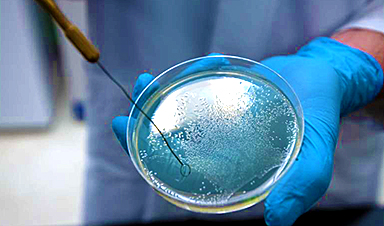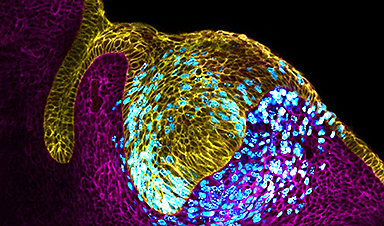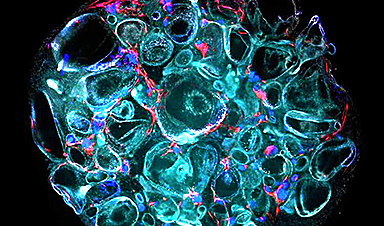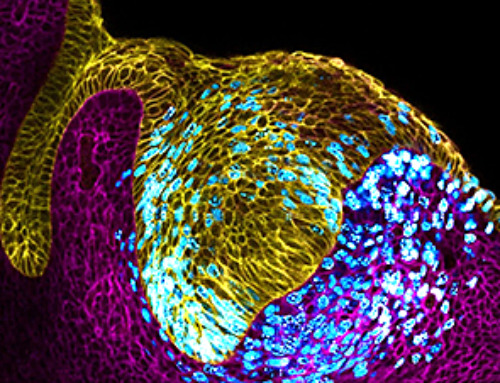Terahertz radiation, whose wavelengths lie between those of microwaves and visible light, can penetrate many nonmetallic materials and detect signatures of certain molecules. These handy qualities could lend themselves to a wide array of applications, including airport security scanning, industrial quality control, astrophysical observations, nondestructive characterization of materials, and wireless communications with higher bandwidth than current cellphone bands.
Now, researchers at MIT, the University of Minnesota, and Samsung have developed a new kind of camera that can detect terahertz pulses rapidly, with high sensitivity, and at room temperature and pressure. What’s more, it can simultaneously capture information about the orientation, or “polarization,” of the waves in real-time, which existing devices cannot. This information can be used to characterize materials that have asymmetrical molecules or to determine the surface topography of materials.
The new system uses particles called quantum dots, which, it has recently been found, can emit visible light when stimulated by terahertz waves. The visible light can then be recorded by a device that is similar to a standard electronic camera’s detector and can even be seen with the naked eye. The device is described in a paper published November 4 in the journal Nature Nanotechnology by MIT doctoral student Jiaojian Shi, professor of chemistry Keith Nelson, and 12 others.
The team produced two different devices that can operate at room temperature: One uses the quantum dot’s ability to convert terahertz pulses to visible light, enabling the device to produce images of materials; the other produces images showing the polarization state of the terahertz waves.
The new “camera” consists of several layers, made with standard manufacturing techniques like those used for microchips. An array of nanoscale parallel lines of gold, separated by narrow slits, lies on the substrate; above that is a layer of the light-emitting quantum dot material; and above that is a CMOS chip used to form an image. The polarization detector, called a polarimeter, uses a similar structure, but with nanoscale ring-shaped slits, which allows it to detect the polarization of the incoming beams.
The researchers demonstrated the capabilities of the detector by taking terahertz-illuminated pictures of some of the structures used in their devices, such as the nano-spaced gold lines and the ring-shaped slits used for the polarized detector, proving the sensitivity and resolution of the system.
Developing a practical terahertz camera requires a component that produces terahertz waves to illuminate a subject, and another that detects them. On the latter point, current terahertz detectors are either very slow, because they rely on detecting heat generated by the waves striking a material, and heat propagates slowly, or they use photodetectors that are relatively fast, but have very low sensitivity. In addition, until now, most approaches have required a whole array of terahertz detectors, each producing one pixel of the image. “Each one is quite expensive,” Shi says, so “once they start to make a camera, the cost of the detectors starts to scale up really, really quickly.”
While the researchers say they have cracked the terahertz pulse detection problem with their new work, the lack of good sources remains—and is being worked on by many research groups around the world. The terahertz source used in the new study is a large and cumbersome array of lasers and optical devices that cannot easily be scaled to practical applications, Nelson says, but new sources based microelectronic techniques are well under development.
“I think that’s really the rate-limiting step: Can you make the [terahertz] signals in a facile way that isn’t expensive?” he says. “But there’s no question that’s coming.”
Sang-Hyun Oh, a co-author of the paper and a McKnight Professor of Electrical and Computer Engineering at the University of Minnesota, adds that while present versions of terahertz cameras cost tens of thousands of dollars, the inexpensive nature of CMOS cameras used for this system makes it “a big step forward toward building a practical terahertz camera.” The potential for commercialization led Samsung, which makes CMOS camera chips and quantum dot devices, to collaborate on this research.
Traditional detectors for such wavelengths operate at liquid helium temperatures (-452 degrees Fahrenheit), Nelson says, which is necessary to pick out the extremely low energy of the terahertz photons from background noise. The fact that this new device can detect and produce images of these wavelengths with a conventional visible-light camera at room temperature has been unexpected to those working in the terahertz field. “People are like, ‘What?’ It’s kind of unheard of, and people get very surprised,” says Oh.
There are many avenues for further improving the sensitivity of the new camera, the researchers say, including further miniaturization of the components and ways of protecting the quantum dots. Even at the present detection levels, the device could have some potential applications, they say.
In terms of commercialization potential for the new device, Nelson says that quantum dots are now inexpensive and readily available, currently being used in consumer products such as television screens. The actual fabrication of the camera devices is more complex, he says, but is also based on existing microelectronics technology. In fact, unlike existing terahertz detectors, the entire terahertz camera chip can be manufactured using today’s standard microchip production systems, meaning that ultimately mass production of the devices should be possible and relatively inexpensive.
Already, even though the camera system is still far from commercialization, researchers at MIT have been using the new lab device when they need a quick way to detect terahertz radiation. “We don’t own one of those expensive cameras,” Nelson says, “but we have lots of these little devices. People will just stick one of these in the beam and look by eye at the visible light emission so they know when the terahertz beam is on. … People found it really handy.”
While terahertz waves could in principle be used to detect some astrophysical phenomena, those sources would be extremely weak and the new device is not able to capture such weak signals, Nelson says, although the team is working on improving its sensitivity. “The next generation lies in making everything smaller, so it will be much more sensitive,” he says.
News
New Research Reveals That Your Sense of Smell May Be Smarter Than You Think
A new study published in the Journal of Neuroscience indicates that the sense of smell is significantly influenced by cues from other senses, whereas the senses of sight and hearing are much less affected. A popular [...]
Deadly bacteria show thirst for human blood: the phenomenon of bacterial vampirism
Some of the world's deadliest bacteria seek out and feed on human blood, a newly-discovered phenomenon researchers are calling "bacterial vampirism." A team led by Washington State University researchers has found the bacteria are [...]
Organ Architects: The Remarkable Cells Shaping Our Development
Finding your way through the winding streets of certain cities can be a real challenge without a map. To orient ourselves, we rely on a variety of information, including digital maps on our phones, [...]
Novel hydrogel removes microplastics from water
Microplastics pose a great threat to human health. These tiny plastic debris can enter our bodies through the water we drink and increase the risk of illnesses. They are also an environmental hazard; found [...]
Researchers Discover New Origin of Deep Brain Waves
Understanding hippocampal activity could improve sleep and cognition therapies. Researchers from the University of California, Irvine’s biomedical engineering department have discovered a new origin for two essential brain waves—slow waves and sleep spindles—that are critical for [...]
The Lifelong Cost of Surviving COVID: Scientists Uncover Long-Term Effects
Many of the individuals released to long-term acute care facilities suffered from conditions that lasted for over a year. Researchers at UC San Francisco studied COVID-19 patients in the United States who survived some of the longest and [...]
Previously Unknown Rogue Immune Key to Chronic Viral Infections Discovered
Scientists discovered a previously unidentified rogue immune cell linked to poor antibody responses in chronic viral infections. Australian researchers have discovered a previously unknown rogue immune cell that can cause poor antibody responses in [...]
Nature’s Betrayal: Unmasking Lead Lurking in Herbal Medicine
A case of lead poisoning due to Ayurvedic medicine use demonstrates the importance of patient history in diagnosis and the need for public health collaboration to prevent similar risks. An article in CMAJ (Canadian Medical Association [...]
Frozen in Time: How a DNA Anomaly Misled Scientists for Centuries
An enormous meteor spelled doom for most dinosaurs 65 million years ago. But not all. In the aftermath of the extinction event, birds — technically dinosaurs themselves — flourished. Scientists have spent centuries trying [...]
‘Mini kidneys’ reveal new insights into metabolic defects in polycystic kidney disease
Scientists at Nanyang Technological University, Singapore (NTU Singapore) have successfully grown 'mini kidneys' in the lab and grafted them into live mice, revealing new insights into the metabolic defects and a potential therapy for [...]
Decoding the Origin of Life: Scientists Solve Early Earth RNA Puzzle
Recent research illustrates how RNA molecules’ chemical characteristics might have played a crucial role in the development of complex life forms. How did complex life manage to evolve on the early, inhospitable Earth? Initially, [...]
Improving infectious disease testing with gold nanoparticles
By harnessing the power of composite polymer particles adorned with gold nanoparticles, a group of researchers have delivered a more accurate means of testing for infectious diseases. Details of their research was published in the [...]
New micromaterial releases nanoparticles that selectively destroy cancer cells
Researchers have developed micromaterials made up only of proteins, capable of delivering over an extended period of time nanoparticles that attack specific cancer cells and destroy them. The micromaterials mimic natural secretory granules found [...]
Alzheimer’s Breakthrough: Scientists Make Revolutionary Leap
Dementia is a major health issue worldwide in the 21st century, impacting over 50 million people globally. This figure is expected to soar to 152 million by 2050, as the global population ages. Alzheimer’s disease (AD) [...]
How small RNA molecules regulate viral infections of bacteria
Viruses need hosts. Whether it's measles, the flu or coronavirus, viral pathogens cannot multiply or infect other organisms without the assistance of their hosts' cellular infrastructure. However, humans are not the only ones affected [...]
Computer scientists discover gap in the latest security mechanisms used by some chips
Over the past few years, hardware manufacturers have developed technologies that ought to make it possible for companies and governmental organizations to process sensitive data securely using shared cloud computing resources. Known as confidential [...]






















